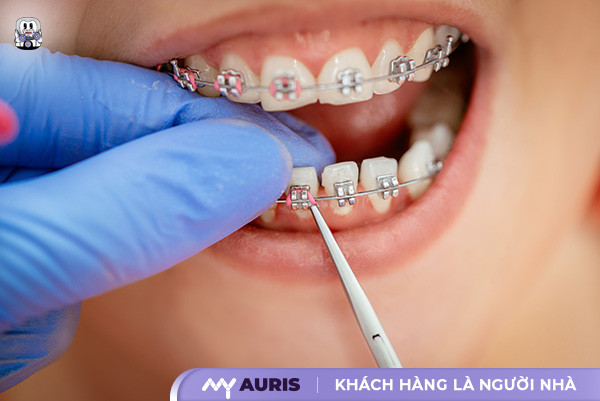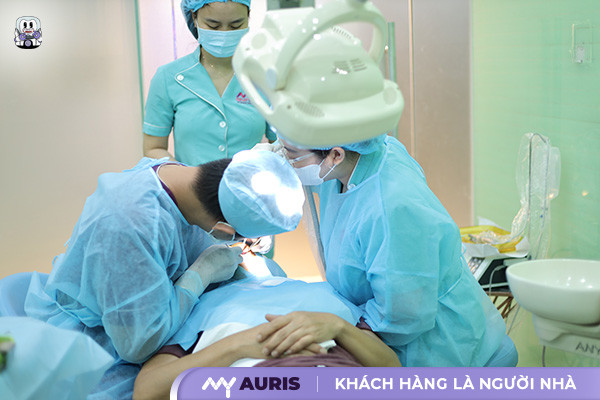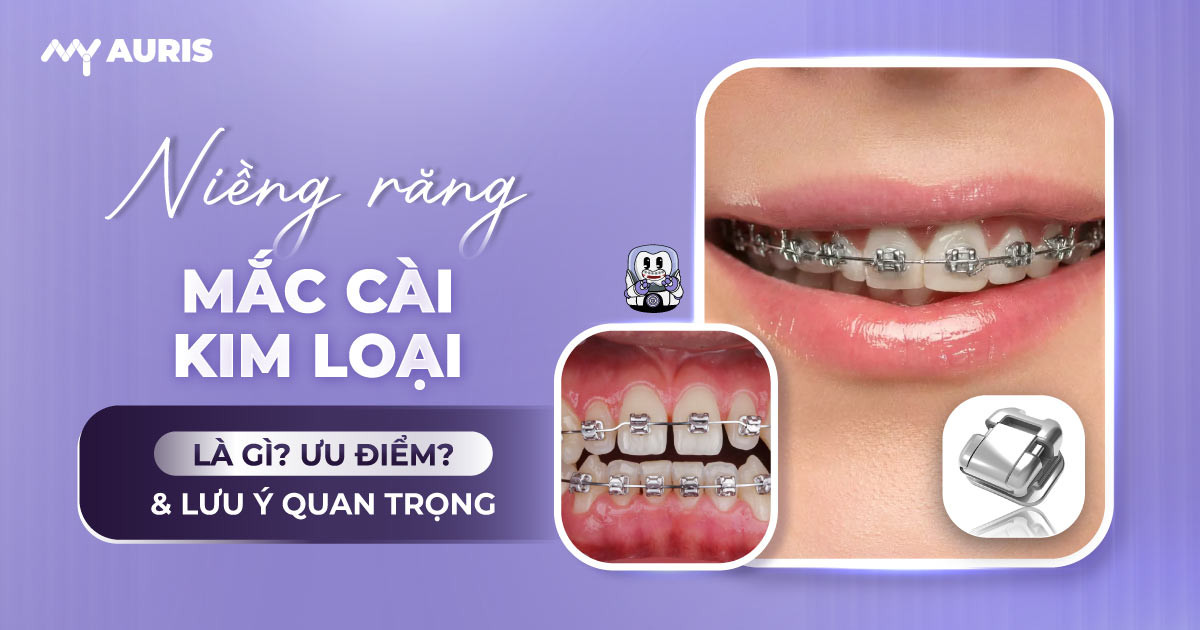Do you want a beautiful, straight smile? Metal braces are a popular and effective orthodontic treatment method. With reasonable costs, this method helps correct many dental problems such as crooked teeth, crowded teeth, or malocclusion. This article by My Auris Dental Clinic will provide detailed information about metal braces, from different types of braces to the treatment process, helping you better understand this method before making a decision.
Detailed Information on Metal Braces
Metal bracket braces are a traditional orthodontic method that has been used for a long time, primarily utilizing nickel-titanium – a highly durable, stainless alloy that provides stable force, effectively correcting misaligned teeth.
This solution is particularly suitable for treating conditions such as underbite, overbite, gaps between teeth, and crooked teeth – from mild to severe. Thanks to the uniform tightening force, the entire set of teeth is impacted, leading to noticeable orthodontic results and simultaneously shortening the treatment duration for metal braces compared to other methods.
Currently, there are 3 popular types of metal braces used in treatment, each possessing unique characteristics suitable for different dental conditions and client needs. Choosing the right type of braces will help optimize the cost of metal braces and ensure long-term results:

Traditional Metal Brackets
Traditional metal braces utilize archwires, brackets, and elastic ties to create pulling force, thereby moving teeth into their desired positions. In cases of complex misaligned teeth, the dentist may recommend orthodontic mini-screws (TADs) to enhance the effectiveness of adjustment. This method has proven long-term effectiveness and reasonable cost.

Lingual Metal Braces (incognito braces)
Lingual braces have a similar structure to traditional braces but are attached to the inner surface of the teeth – where they come into contact with the tongue – instead of the outer surface. This is an ideal choice for those concerned with the aesthetics of braces, as they are difficult to notice during communication. However, the advantages and disadvantages of these braces need careful consideration: oral hygiene becomes more challenging, increasing the risk of periodontitis and bad breath, and they can easily cause tongue irritation due to frequent rubbing.

Self-Ligating Metal Brackets
Unlike traditional types, self-ligating brackets use an automatic locking mechanism instead of elastic ties, ensuring a more secure fixation of the archwire. This design helps prevent elastic ties from stretching or breaking, reduces discomfort, and enhances overall comfort during treatment. It is a highly effective solution and is chosen by many seeking a sustainable aesthetic orthodontic solution.
Common Indications for Metal Braces
Malocclusion
Malocclusion (incorrect bite) is a condition of imbalance between the upper and lower jaws – where teeth do not meet correctly or are off-center on the dental arch. This condition directly affects oral aesthetics and chewing function.
Causes of malocclusion: Genetics: accounts for up to 70% of cases. Misaligned teeth due to lack of space or incorrect eruption position. Bad habits from childhood such as thumb sucking, prolonged pacifier use.
Common types of malocclusion: Underbite, open bite, deep bite, crossbite.
Symptoms: Teeth do not align correctly when the mouth is closed. Jaw fatigue, difficulty chewing. Unclear pronunciation, tendency to lisp. Habit of mouth breathing.
Crowded Teeth
Crowded teeth refer to a condition where teeth erupt out of order, overlap, or push against each other due to insufficient space on the dental arch. This is a form of misaligned teeth and can lead to malocclusion if not treated promptly.
Causes: Genetics or early tooth loss leading to changes in the dental arch. Bad habits during childhood. Improper oral hygiene, leading to gingivitis, periodontitis, or tooth decay.
Misaligned Teeth
Misaligned teeth occur when one or more teeth on the dental arch do not erupt in their correct positions, causing an overall imbalance. This condition affects both aesthetics and chewing function.
Main causes: Genetics, congenital factors. Bad habits such as pacifier use, thumb sucking, tongue thrusting. Early tooth loss or late tooth eruption. Oral diseases such as tooth decay, gingivitis, periodontitis. Improper oral hygiene.
Common symptoms: Ill-fitting teeth, easily biting the inner cheek or tongue. Difficulty chewing. May lisp or breathe through the mouth. Severe cases can cause facial deformation.
Metal braces are an optimal, safe orthodontic method, delivering high effectiveness in just 12–18 months (can extend up to 20 months depending on the severity of misalignment). This method is painless and does not affect daily activities.
Protruding Teeth (Overjet/Overbite)
Protruding teeth (overjet/overbite) is a condition where the teeth or the entire upper jaw protrudes excessively, severely affecting oral aesthetics and the patient’s psychology. Some cases may be accompanied by jaw bone structural abnormalities.
Common causes: Upper teeth erupting outwards incorrectly. Large tooth size compared to the jaw frame. Bad habits such as prolonged pacifier use, thumb sucking. Early loss of baby teeth, leading to misalignment when permanent teeth erupt. Abnormal jaw structure, especially when the upper jaw is overdeveloped.
Advantages and Disadvantages of Metal Braces – The “National” Method in Orthodontics
Key Advantages of Metal Braces
Metal braces have long been considered the “national” method due to their practical benefits and suitability for the majority of users. Here are the outstanding advantages that help this method maintain its position in the field of orthodontics:
High effectiveness and stable force: With orthodontic appliances such as brackets and archwires made from durable metal, this method ensures stable force, resisting breakage throughout the treatment process. As a result, patients can be completely assured of the orthodontic effectiveness, without worrying about interruptions or prolonged treatment times.
Shorter treatment time:
Compared to many other modern methods, metal braces help shorten treatment time due to the stability of the bracket system, allowing teeth to move quickly and consistently.
Low cost, easy access:
This method has been available for a long time, involves a simple procedure, and has a reasonable cost – only about 27 – 35 million VND per case, depending on the dental condition. Thanks to its affordable price, it is an ideal choice for those who want to improve their smile while staying within budget.

Disadvantages to Consider with Metal Braces
Despite their many advantages, metal braces still have some limitations that users need to consider:
Less aesthetic:
Metal brackets are easily visible when communicating, smiling, or eating, causing many people to lose confidence in their daily activities.
Prone to oral problems:
Food can easily get trapped in the braces, making oral hygiene challenging. Without proper care, the risk of tooth decay, gingivitis, and bad breath will increase.
Brackets can easily detach:
In some cases using elastic ties, brackets may detach during eating or strenuous activities, affecting the treatment process.
Feeling of bulkiness and discomfort:
During the first few weeks, brace wearers will experience discomfort, a bulky feeling, and even irritation to the tongue and cheek lining as they adjust to the appliances in their mouth. To reduce discomfort, it is advisable to eat soft, liquid, and easily swallowed foods during the initial phase.
How Much Do Metal Braces Cost?
“How much do metal braces cost?” is a question many people ponder when researching orthodontic methods. In reality, this price is not fixed but depends on two key factors: the treatment method and the specific dental condition of each individual.
At My Auris Dental Clinic, metal braces are divided into three main types:
- Traditional metal braces: use elastic ties to secure the archwire. This is the basic method, with the most economical cost.
- Self-ligating metal braces: feature an automatic cap to secure the archwire, reducing friction and shortening treatment time. The cost is higher than the traditional method.
- Lingual metal braces: are attached to the inner surface of the teeth, helping to “hide” the brackets, offering high aesthetics but also entailing a higher cost for metal braces due to the complex technique.
Each dental misalignment condition – from simple to complex – will directly affect the cost of braces. Severely misaligned teeth, serious malocclusion, or crowded teeth require the dentist to apply more orthodontic techniques, taking more time and effort.
At My Auris, the complexity levels for braces treatment are clearly divided from Level 1 to Level 3. Each level corresponds to a different cost, specifically as follows:
| No. | Service Package | Level | Listed Price (VND) |
| 1 | Standard Metal Brackets | Level 1 | 25,000,000 |
| Level 2 | 30,000,000 | ||
| Level 3 | 35,000,000 | ||
| 2 | Self-Ligating Metal Brackets | Level 1 | 35,000,000 |
| Level 2 | 40,000,000 | ||
| Level 3 | 45,000,000 | ||
| 3 | Standard Ceramic Brackets | Level 1 | 30,000,000 |
| Level 2 | 35,000,000 | ||
| Level 3 | 40,000,000 | ||
| 4 | Self-Ligating Ceramic Brackets | Level 1 | 50,000,000 |
| Level 2 | 55,000,000 | ||
| Level 3 | 60,000,000 |

Standard Dental Procedure for Metal Braces
Metal braces are a popular orthodontic solution, providing high effectiveness in correcting misaligned teeth. Below are 7 basic steps in the metal braces procedure, ensuring safety and achieving desired results:
Step 1 – Dental Examination and Pre-Orthodontic Consultation
First, the dentist will conduct a dental examination, take X-rays, and impressions of the teeth to assess the overall oral condition. Based on the examination results, the doctor will develop a suitable treatment plan to optimize the effectiveness of the braces.
Step 2 – Develop a Personalized Treatment Plan
If the patient’s teeth are completely healthy, the orthodontic procedure will begin promptly. Conversely, for issues such as pulpitis, gingivitis, etc., the dentist will treat these conditions thoroughly before attaching the orthodontic appliances.
Step 3 – Bracket Placement and Auxiliary Device Attachment
In this step, the dentist will proceed with attaching the metal brackets to the teeth – a process that typically lasts about 1 hour. In cases of a narrow dental arch, an expander might be needed to create space before orthodontic treatment.
Step 4 – Archwire Tension Adjustment
Once the brackets are fixed, the dentist monitors tooth movement and adjusts the archwire appropriately for each stage.
Step 5 – Fine-Tuning Brackets According to the Treatment Plan
Regular bracket adjustments ensure that teeth move in the correct direction and at the right speed according to the established plan, effectively contributing to shortening the orthodontic treatment time.
Step 6 – Regular Check-ups and Timely Intervention
Every 3–6 weeks, clients will have follow-up appointments for the dentist to replace elastic ties, lip bumpers, adjust pulling forces, etc. This helps detect and promptly address any issues that arise during the bracing process.
Step 7 – Braces Removal and Post-Treatment Care
Once the teeth are stable in their desired positions, the dentist will proceed with removing the braces. Depending on the case, the debonding period can range from 6 months to 1 year, up to a maximum of 3 years. Afterwards, the dentist will provide instructions on post-braces dental care and schedule follow-up appointments to maintain long-lasting orthodontic results.
My Auris Dental Clinic – Reputable and Specialized Metal Braces Provider in HCMC
If you are looking for a reputable dental clinic with a team of experienced orthodontists, quality services, and modern technology, then My Auris Smart Dental Clinic is a trustworthy choice.
The entire process, from orthodontic consultation, dental examination, to the procedures for metal braces or ceramic braces, is directly performed by orthodontists with many years of experience. All customer inquiries before, during, and after treatment are answered specifically and clearly.
At My Auris Dental Clinic, every client signs a transparent orthodontic contract. The contract specifies the duration of braces treatment, the 3D orthodontic analysis roadmap, and the degree of tooth movement at each stage. This is a differentiating factor that gives clients complete peace of mind during treatment – something not all dental clinics can provide.
Auris heavily invests in modern dental equipment such as: precise impression-taking devices, Vceph 3D software for accurate 3D orthodontic analysis, and personalized orthodontic treatment plan development. Sterile, private dental rooms ensure absolute safety for each treatment case.
Beyond its professional expertise, My Auris Dental Clinic also stands out for its professional dental service quality. Clients will be welcomed and assisted by a friendly, dedicated team of consultants, making the aesthetic braces treatment process more pleasant and comfortable.
Contact My Auris Dental Clinic immediately for a free orthodontic consultation. A real-world experience here will help you understand why many people choose Auris as a leading reputable orthodontic provider and leave many positive My Auris dental reviews on various platforms.

6 Important Considerations for Metal Braces: Don’t Miss Them!
Metal braces are a popular, highly effective, and reasonably priced orthodontic method. However, to achieve optimal results, you need to keep the following in mind when undergoing metal braces treatment:
Check for metal allergy:
Before starting metal braces treatment, ensure that you are not allergic to metal. If you show signs of sensitivity, consult your doctor immediately for suitable alternatives such as ceramic braces or clear aligners.
Attend scheduled follow-up appointments:
Regular follow-up appointments help the dentist closely monitor tooth movement and promptly adjust if there are signs of misalignment or complications.
Maintain proper oral hygiene with braces:
Brush your teeth at least twice a day and clean between teeth approximately 30 minutes after meals using dental floss, a water flosser, etc., to minimize plaque buildup and prevent tooth decay and gingivitis.
Avoid harmful foods with braces:
Foods to avoid when wearing braces include hard, chewy, sticky, or highly adhesive foods such as candy, sticky rice cakes, carbonated drinks, etc., as they can easily dislodge or break brackets.
What to do if a bracket detaches or breaks:
If a bracket detaches, do not attempt to fix it yourself. Visit the dental clinic as soon as possible for the dentist to reattach it correctly, ensuring it does not affect the treatment progress.
Wear orthodontic appliances & elastic bands as instructed:
Follow the dentist’s exact instructions regarding wearing orthodontic appliances and elastic bands to ensure teeth move in the correct direction, with the right force, and within the prescribed timeframe.
Remember and fully apply the 6 tips above to ensure an effective metal braces treatment process, minimize risks, and achieve your desired straight and beautiful smile sooner.





